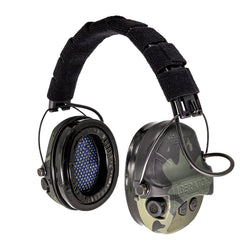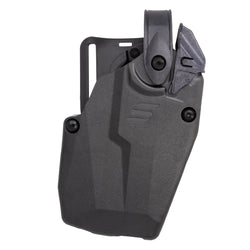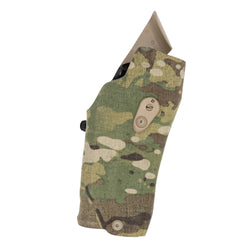You would have to be asleep to not notice the rise in popularity of lever guns lately. From the Marlin 1895s reborn under the Ruger label to the fully customized threaded-barrel and MLOK variants from Mad Pig Customs, lever guns are making a comeback.
Then again, they have been around for well over a century, and they have always been popular among hunters, trappers, and outdoorsmen. Everyone has an uncle or relative who owns a trusty “thirty-thirty,” and most of those are now valued at three to four times the original price.
I’ve owned several lever guns, but the one in my collection that has no equal is the take-down .457 WWG Co-Pilot from Wild West Guns.
The Build
The Wild West Guns Co-Pilot started its life as a Marlin 1895 18-inch stainless steel guide gun. In that configuration, the rifle came with a laminated grey/green stock with a straight grip stock and a tubular magazine that accommodates six plus one rounds.
The rifle was then sent to Wild West Guns for the conversion. This process includes cutting the barrel down to 16.5 inches if desired, installing the Wild West Guns Recoil Porting System, tuning the action for reliability, installing the WWG bear-proof ejector, and, of course, the precision-machined take-down system.
My Co-pilot has the larger trapper loop installed that really helps with using the lever with gloves and even mittens on, and there is less of a chance of the lever smacking into my fingers under recoil.

In addition to the upgrades made to the internals, my Co-pilot is equipped with a barrel-mounted Picatinny rail for scout-optic carry and a rear Skinner Express peep sight.

When I acquired the rifle from my friend, it came with a silver-finish Leupold intermediate eye relief scope. This optic came with a German #1 post-style reticle, and it worked well in the classic Jeff Cooper scout rifle configuration. That concept allows for using both eyes open with a rifle, and it pre-dated the low-powered variable optic.
To further reduce the overall dimensions and make the rifle even handier, an Aimpoint H2 was provided by my friends at The Powder Room in Panama City Beach, FL. This optic cut the weight on the top of the rifle from 10.4 ounces to 4.6 ounces.

Ballistics
The .45-70 cartridge was developed originally in 1873 for the U.S. military. At one time, it was known as THE buffalo hunting cartridge. One look at the .45 caliber 405 grain bullet, originally powered by 70 grains of powder, and you’ll understand why this caliber is no lightweight. The .45-70 has been tweaked over the years to include modern smokeless powder and both large-scale manufacturers and specialty shops are turning out rounds for everything from large game to dangerous game.

I chronographed my Wild West Guns Co-Pilot with various ammo using a Garmin Xero.
Buffalo Bore 8A ammunition with a 430-grain hard-cast penetrator bullet is listed as achieving 1879 feet per second out of an 18.5-inch 1895 Marlin on the Buffalo Bore website. Out of my rifle, my five-round average velocity was 1845 feet per second. The 8B offering lists on the Buffalo Bore site as 1955 feet per second out of the 18.5-inch barrel, and my personal rifle achieved 1930 feet per second.
With Hornady 325-grain FTX rounds, my rifle had an average velocity of 1855 feet per second. The most scorching results came from 350 grain HSM .457 Magnum rounds that clocked in at 2120.4 feet per second.

Perhaps the most interesting trick this rifle can perform is single-loading and firing 2.5-inch .410 gauge shells. Slugs and buckshot aren’t the draw here, but rather bird and small game shot.
Instead of toting a rifle and a shotgun into the backcountry for possible game getting in a survival scenario, the WWG Co-Pilot can do it both. The birdshot-delivering function of this rifle would work well in the Alaskan bush, as ptarmigan and parky squirrels are abundant.

Performance and Field Use
Disassembly and assembly of the rifle takes less than 30 seconds. A small screw located at the underside of the magazine tube is loosened, and the magazine tube is pulled forward slightly. This moves the magazine tube follower out of the way of the receiver. The action of the rifle is opened, and the barreled forend and receiver are twisted and unscrewed.
Reassembly is a matter of reversing the process, starting with opening the action, screwing the barreled forend into place, and tightening down the small screw underneath the magazine tube.

The rifle rides low over the shoulder, and it balances well in the hand when carried at the junction where it takes down. The WWG Co-Pilot is a compact powerhouse of a defensive firearm, and it packs down to fit inside a takedown .22 rifle case from Galati Gear. The rifle weighs in at 7.8 lbs, and the travel case with 10 rounds of 325 grain ammunition in an MTM case guard adds an additional 1.98 lbs.
Maintenance is almost non-existent with the converted 1895 guide gun. Lever actions are typically robust in nature, and the stainless finish of this rifle makes it an excellent choice for use in damp conditions. On the rare occasion the rifle is cleaned, a bore snake is used along with a few passes of patches with Ballistol.

I have not used this rifle for white-tail deer hunting yet, but the season for that is coming up. While some would argue the .45-70 is too much for that type of hunting, many have been taken by hunters with good shot placement and minimal meat waste.
Here in North Carolina and back in Connecticut where I hunt more regularly, the woods don’t offer too many wide-open shots beyond 60 yards, which is well within the capability of the rounds fired. Keep in mind, the .45-70 has been used in long-range shooting at incredible distances and well within 300 yards by hunters. It will serve me perfectly fine wherever I go.
The Trade-Offs
Firearm reviews that don’t point out obvious issues provide a disservice to the reader. The number one reason why most will never purchase the WWG Co-Pilot is the cost. A standard 1895 Guide Gun costs close to $1000, while the fully customized Co-Pilot is three to four times that price. I purchased mine second-hand from a dear friend at a significant discount, but even the price I paid is too high for most.
Additionally, feeding the WWG Co-Pilot the best ammunition will not be inexpensive. Some of the rounds used in the chronograph testing cost more than four dollars a round. The lever gun is legal just about anywhere in the country, but it gives up speed of reloading and capacity to do so.
The most jarring trade-off is recoil. Compared to a semi-automatic shotgun loaded with slugs, a lightweight lever gun like this will transfer all of the recoil into the user. The recoil-shy need not apply to use this rifle for much more than a few rounds.

The Why
To say I travel a lot is an understatement. I’ve learned the inside and out of too many airports to mention. As a bushcraft and survival instructor, my work takes me to remote parts of the country where dangerous game call home.
Before I ever make the first move to raise the sights of this rifle on a charging animal, I’m going to respect its home and employ the best practices of avoidance. Killing an animal in self-defense can be a legal nightmare and bring far too much attention to me than I’m comfortable with.
If I do have to use a gun to defend myself, I want to bring enough gun. My Glock 20 in 10mm and revolvers are great for convenience, but they simply cannot do what the .45-70 does.
The take-down capability lets me pack the co-pilot in a backpack, inside the confines of my kayak/canoe dry bags, and well within the dimensions of my smaller and lighter Pelican cases. It has been carried with me to Alaska, Wyoming, Maine, and many points in between.
Simply put, this rifle is the perfect choice for a companion, or co-pilot in all of my adventures.










